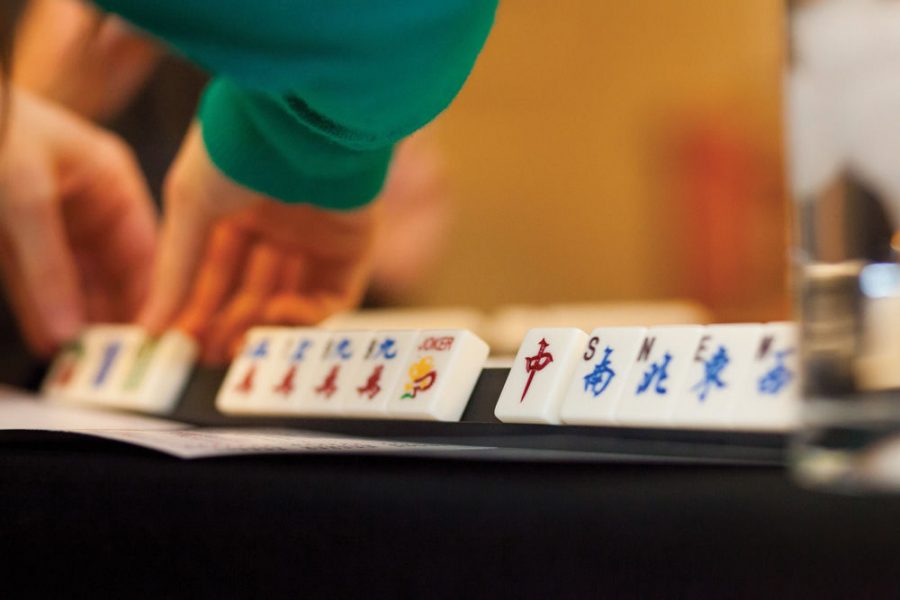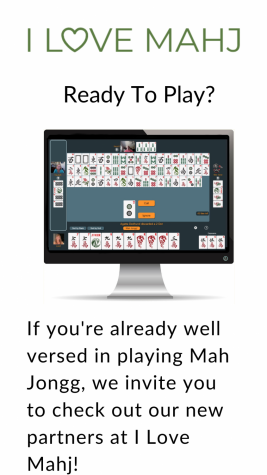This Week in Mah Jongg: Strategic Thinking
Published September 7, 2021
Hello, again! In previous articles, we’ve focused on the mechanics of the game, packing our tutorials full of great information for newbies getting started with American Mah Jongg. They are also a perfect refresher for those who haven’t played in a while. Now, though, it’s time to turn our attention to the exciting topic of game strategy!
Becoming familiar with the fundamentals is just the starting point. The real fun begins when you’ve developed enough confidence in your playing ability to be able to add game strategy into the mix!
A player’s flexibility and decision-making skills can give them the edge over their competitors. Like any game, there isn’t necessarily a single "best" strategy for a particular situation. A player must adjust their moves depending on a variety of factors (ie, how many tiles remain in the wall, how close they are to Mah Jongg, other players’ exposures, the probability that a particular tile is needed, and their personal style). In this article, we will offer general advice and we’ll build on this over the coming weeks.
ADVERTISEMENT
Introduction to Game Strategy
"I have nothing!" This is the common lament of many Mah Jongg players once their initial tiles have been racked and scrutinized. It's true that luck has a large part to play in the game, but whether you're playing in person or online, having a good grasp of strategic and tactical moves can dramatically increase your chances of turning this "nothing" hand into a winning one.
Over the next few weeks, we will discuss various strategies to help you make the most of your tiles and win more often. We’ll be taking a big picture view of strategy and offering advice that can be applied no matter which year’s National Mah Jongg League card you may be playing with.
The tips we’ll be offering have been gathered over many years, from our own experiences and also from the wisdom imparted by other experienced players. We are thankful to all those who have helped us improve our game.
ADVERTISEMENT
As previously mentioned, there is rarely a "best Mah Jongg strategy" for a given situation. Often there are several options and you'll need to pick one and run with it. We will provide hints along the way to help steer you in the right direction, but remember that these strategies are not rigid rules to follow. Flexibility is definitely the name of the game!
Our series of strategy-based tutorials will assume you have mastered at least the basics of American Mah Jongg and are familiar with its rules and practices. If you're new to the game, please check out our previously published articles, covering Mah Jongg fundamentals. You can do this by using the magnifying glass at the top right of this page and searching for the term “Mah Jongg”.
Since many of our tips depend on the phase of the game currently being played, we'll be breaking our articles down into the following sections:
- General advice (valid throughout the game)
- Receiving and organizing your tiles
- Charleston strategy
- Early-game strategy
- Mid-game strategy
- End-game strategy
We’ll also include bonus sections on joker strategy and how to read Mah Jongg hands.
As there’s a lot to cover, our strategy tips will be broken down and published over the next few weeks. We’ll aim to be as thorough, and provide as much value, as possible, for all skill levels. So, let's get started!
And don't forget, you can practice your newly acquired skills on I Love Mahj, the American Mah Jongg online game!
General Advice
Be prepared
The first (and arguably most important) piece of advice we'd like to give you is to prepare for the game. Mah Jongg is a fast-paced game and if you take too long to think through your options, you'll feel your stress levels rising, you'll make goofy mistakes, and win fewer games.
On top of all that, you're likely to feel the frustration of your fellow players, who wish to keep the game moving and this is likely to raise your blood pressure even higher!
So, it's important to familiarize yourself with the current year's card. You need to know not only the general categories in order to narrow down your initial hand choices, but also the idiosyncrasies of each. Yes, this may seem a little daunting, but it's a worthy investment of your time. It’ll allow you to quickly "pattern-match" between your tiles and the available hands (without having to look at all possible options), and will give you the edge over others.
Here are a few strategies to help you master the card:
- Examine the card, making notes of patterns. For example:
- Hands with flowers
- Hands with dragons
- Hands with winds
- Hands with singles
- Hands with mixed suits
- Various shapes (eg: 2 pairs/2 pungs/1 kong or 2 pairs/2 quints)
- Ascending hands
- Gate hands (kongs on the end and pairs in the middle)
- Math-based hands
- Etc
- If you own a set, work through each hand on the card, setting out 2 or 3 winning combinations of tiles for each (this will help you memorize the hand and easily recall it later)
- Run through a Charleston on your own. Pick 13 random tiles and look through the card for matches. What are your options? What would you discard? Take your time to examine each hand. Now is the time to methodically examine your options, since you're on your own and not holding up the game
- Play a few trial games with friends who are also willing to practice. Give each other as much time as needed, without the usual pressure of a real game
- Practice with robots using an online Mah Jongg game, such as I Love Mahj (bots don't get antsy when you take too long to think).
For other interesting forms of practice, check out Michele Frizzell's YouTube channel.
Be patient
Don’t call a discard too early in the game. This reveals your direction to others and narrows your options. More on this later.
Be observant
- Be aware of tiles being passed in the Charleston and Courtesy Pass
- Watch for exposures
- Always be aware of exposed jokers and don't miss an exchange on your next turn
- Be aware of the types of tiles each player is discarding
- Watch the body language of other players, particularly when tiles are picked, discarded, or exposures made
- Learn the playing style of the people you regularly play with
Be flexible
Keep your options open (at least initially) and be willing to switch to another hand, having observed the discards and exposures of others.
Be defensive
We often hear in various sports “The best offense is a good defense” and that's true in Mah Jongg also. We would argue this is what differentiates average players from great players. Again, keep close tabs on what others are playing, determine their hands and watch your discards accordingly.
If you realize you cannot win, switch to full defensive mode, actively doing everything you can to prevent others from winning. This is all part of the game and is in no way unethical (more details will be covered when we discuss end-game strategies).
Be secretive
Do your best to keep your hand choice a mystery by:
- Controlling your reactions to picks, discards, and exposures
- Keeping your hand concealed for as long as possible
- Being careful how you organize the tiles on your rack and where you place your new picks (we’ll discuss tile organization in our next article)
Be quick
- Try not to interrupt the flow of the game by overthinking. This is why we emphasized the need to practice and study the card. That being said, do not be so quick as to play recklessly and make mistakes. It's definitely a balancing act. Remain calm, take a few deep breaths and work through your options as swiftly as you possibly can
- When it’s your turn, pick and rack your tile quickly to limit other players' opportunity to call the previous discard. Although this should be done quickly, there’s certainly no need to be too aggressive with your speed here. Your hand should remain behind your rack until it’s your turn, it certainly should not be hovering anywhere near the wall prior to the previous discard being placed on the table. The aim is to close the window of opportunity, but not to take the fun out of the game. A good rule of thumb is to leave a few seconds after the previous discard, before picking and immediately racking your tile.
That’s enough to get started with. We hope you enjoyed reading our general advice and next time we’ll turn our attention to tile organization and choosing a hand.
Q&A’s
Readers’ questions:
Q: I started to discard a tile, but realized I wanted to keep it. Can I take it back and discard another tile?
A: It depends. Did you fully name the tile, or place it on the table? If you had done either of these then there is no going back, the tile has been discarded. If not, feel free to return the tile to the sloped part of your rack and discard another.
Q: Two players called the same tile for an exposure, who gets it?
A: If both players have verbally stated their interest in a discarded tile and no other action has occurred, then the player next in line to the discarder (in counter-clockwise order) would be awarded the tile. However, if one player had called the discard and had already exposed tiles on their rack, they get to keep the tile even if a player next in line were to decide to call the discard. If you snooze you lose!
Q: Somehow I ended up with only 12 tiles. What happens now?
A: Technically your hand is dead. However, as a player, you should never declare your own hand dead. You would continue playing until another player notices the issue and declares your hand dead. As you can no longer win, you should play defensively with the aim of preventing anyone else from achieving Mah Jongg.
Q: Do I have to place my wall tile onto my rack first, before discarding? Often, I just want to discard it straight away.
A: There is no rule that says you have to rack your wall tile. However, racking your tile is the signal that the previously discarded tile is no longer available to other players. It is good practice to ALWAYS rack your tile and then decide to keep or discard.
That’s all for now, folks. Keep your questions coming! Please email them to [email protected].

















